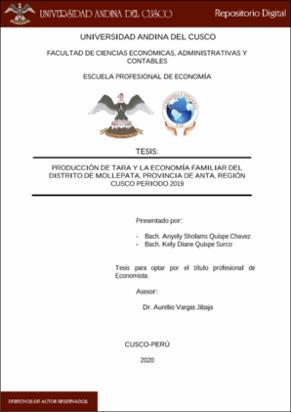| dc.contributor.advisor | Vargas Jibaja, Aurelio | |
| dc.contributor.author | Quispe Chavez, Anyely Sholams | |
| dc.contributor.author | Quispe Surco, Kely Diane | |
| dc.date.accessioned | 2021-02-09T22:13:15Z | |
| dc.date.available | 2021-02-09T22:13:15Z | |
| dc.date.issued | 2020-05-21 | |
| dc.identifier.uri | https://hdl.handle.net/20.500.12557/3655 | |
| dc.description.abstract | La investigación analiza el efecto del cultivo, el poder de comercialización de los
productores y la capacidad productiva en la economía familiar de los productores de Tara del
distrito de Mollepata en la provincia de Anta, Departamento del Cusco durante el año 2019.
Se realizaron encuestas a los productores de Tara para identificar el efecto de las tres variables
independientes antes mencionadas. El diseño de la investigación es no- experimental y de
corte transversal. Entre los principales resultados, se puede mencionar que un mayor nivel de
cultivo genera un mayor nivel de ingreso y ahorro. En promedio, un cultivo de 100 kilos más,
genera un incremento del ingreso en 2.2%, y el ahorro en 2.3%. El poder de comercialización
de los productores está representado por la pertenencia a una asociación, el acceso a los
proveedores de granos y el precio de venta. Un productor con acceso a proveedores de granos
tiene un ingreso entre 46.4% y 49.2% mayor en comparación con un productor que no tiene
acceso a proveedores de granos. Por otro lado, un productor con acceso a proveedores de
granos tiene un ahorro entre 89.1% y 94.3% más que un productor que no tiene acceso a
proveedores de granos. Por último, la capacidad productiva está representada por el número
de plantones cosechados y la utilización de prácticas agrícolas. Se puede observar que el
número de plantones cosechados tiene un efecto menor y no significativo en el ingreso y
ahorro. Es decir, el cultivo y el acceso a proveedores de granos son los principales factores
influyentes del ingreso y ahorro en la producción de Tara del distrito de Mollepata. En
comparación con el Proyecto de Inversión de DIRAGRI, se ha encontrado que este proyecto
ha tenido efectos positivos en la producción de Tara, específicamente porque este proyecto
buscaba proveer asistencia técnica a través de capacitaciones y relaciones con los productores
de granos, respecto a este último punto, se ha encontrado una relación estadísticamente
significativa y positiva entre los proveedores de granos y la economía familiar (ingreso y
ahorro). | es_PE |
| dc.description.abstract | This research analyzes the effect of crops, marketing power and productive capacity
in the family economy of Tara farmers in the Mollepata District in the province of Anta,
Department of Cusco during 2019. Farmer surveys were conducted to identify the effect of
the three independent variables mentioned above. The research design is non- experimental
and cross-sectional. About the main results, it can be mentioned that a higher level of crops
generates a higher level of income and savings. On average, a production of more than 100
kilos, generates an increase in income by 2.2%, and savings by 2.3%. The savings and
business power are represented by membership in an association, access to grain suppliers and
the sale price. A farmer with access to grain suppliers has an income between 46.4% and
49.2% higher compared to a farmer who does not have access to grain suppliers. On the other
side, a farmer with access to grain suppliers has a saving between 89.1% and 94.3% more
than a farmer who does not have access to grain suppliers Finally, the productive capacity is
represented by the number of seedlings harvested and the use of agricultural plants. It can be
seen that the number of seedlings harvested has a minor and not significant effect on income
and savings. The crops and access to grain suppliers are the main influencing factors of
income and savings in the production of Tara from the Mollepata district. Compared to the
DIRAGRI Investment Project, it has been found that this project had positive effects on the
production of Tara, specifically because this project sought to provide technical assistance
through training and relationships with grain farmers, about the last topic, it has been found
a statistically significant and positive relationship between grain access to grain and the
family economy (income and savings). | en_US |
| dc.description.uri | Tesis | es_PE |
| dc.format | application/pdf | es_PE |
| dc.language.iso | spa | es_PE |
| dc.publisher | Universidad Andina del Cusco | es_PE |
| dc.rights | info:eu-repo/semantics/openAccess | es_PE |
| dc.rights.uri | https://creativecommons.org/licenses/by-nc-nd/2.5/pe/ | es_PE |
| dc.source | Universidad Andina del Cusco | es_PE |
| dc.source | Repositorio Institucional UAC | es_PE |
| dc.subject | Proveedor | es_PE |
| dc.subject | Granos | es_PE |
| dc.subject | Capacidad productiva | es_PE |
| dc.subject | Productores | es_PE |
| dc.title | Producción de tara y la economía familiar del distrito de Mollepata, provincia de Anta, región Cusco periodo 2019 | es_PE |
| dc.type | info:eu-repo/semantics/bachelorThesis | es_PE |
| thesis.degree.name | Economista | es_PE |
| thesis.degree.grantor | Universidad Andina del Cusco. Facultad de Ciencias Económicas, Administrativas y Contables | es_PE |
| thesis.degree.level | Titulo Profesional | es_PE |
| thesis.degree.discipline | Economía | es_PE |
| dc.publisher.country | PE | |
| dc.subject.ocde | https://purl.org/pe-repo/ocde/ford#5.02.01 | en_US |
| renati.advisor.dni | 23938021 | |
| renati.advisor.orcid | https://orcid.org/0000-0002-4203-9646 | en_US |
| renati.author.dni | 75170254 | |
| renati.author.dni | 72641175 | |
| renati.discipline | 311016 | |
| renati.juror | Vargas Castillo, Ruben Dario | |
| renati.juror | Santandar Medina, Cecilia Clorinda | |
| renati.juror | Beizaga Ramirez, Walter Claudio | |
| renati.juror | Jordan Pareja, Jorge Luis | |
| renati.level | https://purl.org/pe-repo/renati/level#tituloProfesional | es_PE |
| renati.type | https://purl.org/pe-repo/renati/type#tesis | es_PE |


